Ence Energia Y Celulosa Bundle
Who Really Owns Ence Energía y Celulosa?
Unraveling the Ence Energia Y Celulosa SWOT Analysis is just the beginning; understanding its ownership is key to grasping its future. From its roots as a publicly-owned entity to its current standing as a publicly traded company, Ence's ownership structure has undergone a fascinating transformation. This shift has profoundly impacted its strategic direction and operational focus.
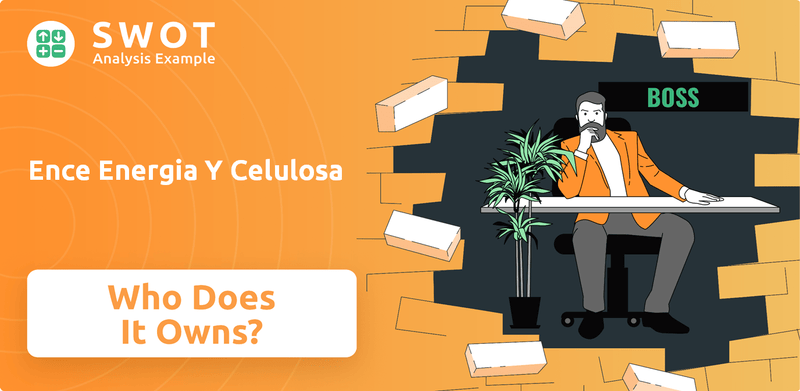
The Ence Energia Y Celulosa story is one of strategic evolution, with its ownership mirroring its changing ambitions. Knowing who the Ence shareholders are and how they influence the company is crucial for any investor. Exploring the Ence company's ownership structure provides valuable insights into the forces shaping its performance and long-term prospects, including the influence of the Ence CEO and key personnel.
Who Founded Ence Energia Y Celulosa?
The story of Ence Energía y Celulosa, or Ence, began in 1957. It started with the creation of three companies: Empresa Nacional de Celulosa de Pontevedra, Empresa Nacional de Celulosa de Huelva, and Empresa Nacional de Celulosa de Motril. These were all established by the Instituto Nacional de Industria (INI), which was a holding institute owned by the Spanish government.
In 1968, these three entities merged to form Empresa Nacional de Celulosa, S.A., which is the direct predecessor of the current Ence. This initial structure highlights that Ence was originally a publicly-owned company. The Spanish government, through INI, was the sole owner. This setup reflected the government's vision for industrial development in the pulp sector.
During its early years, Ence did not have individual founders in the traditional sense. The ownership was entirely governmental. The state's industrial policy guided the company's direction and strategy. From the beginning, Ence focused on exports, a strategy it still uses today. There were no early investors or private individuals holding equity. This was because the company operated under a state-controlled model. Early agreements like vesting schedules or buy-sell clauses were not applicable in this context.
Ence's initial ownership was entirely governmental. The Spanish government, through the INI, controlled the company.
There were no individual founders or private entrepreneurs. The company operated under state control, with no early backers.
From its inception, Ence prioritized exports. This strategy has remained a key part of its business model.
The sale of the Motril facility in 1987 and the acquisition of Celulosa de Asturias, S.A. in 1999 were significant changes.
Ence operated under a state-controlled model. This meant that the government dictated the strategic direction.
Early agreements such as vesting schedules or buy-sell clauses were not applicable because of the state-controlled model.
The early years of Ence, and its ownership structure, were defined by government control and a focus on industrial development. The company's evolution from state ownership to its current form is a key part of its history. Understanding the Revenue Streams & Business Model of Ence Energia Y Celulosa provides further context.
- Ence Energia Y Celulosa began as a state-owned entity.
- The Spanish government, through INI, held complete control.
- The primary focus was on exporting pulp products.
- Significant changes included facility sales and acquisitions.
Ence Energia Y Celulosa SWOT Analysis
- Complete SWOT Breakdown
- Fully Customizable
- Editable in Excel & Word
- Professional Formatting
- Investor-Ready Format
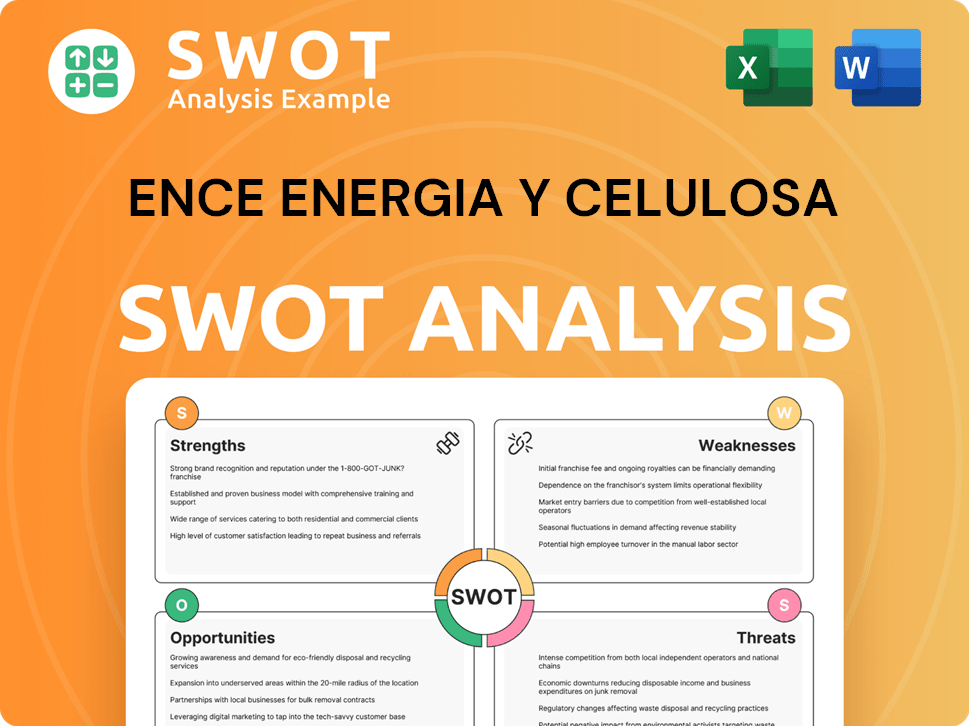
How Has Ence Energia Y Celulosa’s Ownership Changed Over Time?
The evolution of Ence Energia Y Celulosa's ownership reflects a significant transition from a state-owned entity to a publicly traded company. Initially linked to the Instituto Nacional de Industria (INI), the company underwent its initial public offering (IPO) in 1990, which privatized 49% of the company. The remaining 51% was privatized in 2001, completing its transformation into a fully privately-owned, publicly listed entity on the Spanish stock exchange. The company's name changed to ENCE Energía y Celulosa, S.A. on April 26, 2012.
As of June 2025, Ence Energia Y Celulosa is a publicly held company. The company's shares trade on the Spanish stock exchange and are part of the Ibex Medium Cap index. The company's market capitalization is approximately €0.68 billion. The company's financial reports and public filings with the CNMV (Spain's National Securities Market Commission) contain detailed information on institutional investors, mutual funds, and individual insiders.
| Ownership Timeline | Key Events | Impact |
|---|---|---|
| Pre-1990 | State-owned under INI | Limited market influence; strategic alignment with government objectives. |
| 1990 | Initial Public Offering (IPO); 49% privatization | Partial market exposure; introduction of shareholder influence. |
| 2001 | Full privatization | Complete market orientation; increased focus on shareholder value. |
Major stakeholders of Ence Energia Y Celulosa typically include institutional investors and significant individual shareholders. Entities like Retos Operativos XXI, S.L. and Mendibea 2002, S.L. have been mentioned in relation to the board. The company's annual financial reports for 2024, approved on February 28, 2025, and the sustainability report for 2024, approved on April 3, 2025, provide detailed financial and operational data. Changes in Ence ownership directly affect company strategy and governance, influencing decisions related to investments, dividends, and overall business direction. For more details about the company, you can read about the Target Market of Ence Energia Y Celulosa.
Ence shareholders include a mix of institutional investors and individual shareholders.
- Institutional investors play a significant role in influencing company strategy.
- Individual shareholders may also hold substantial stakes.
- Ence stock performance is influenced by the decisions of major shareholders.
- The Ence CEO and key personnel are responsible for implementing the strategies.
Ence Energia Y Celulosa PESTLE Analysis
- Covers All 6 PESTLE Categories
- No Research Needed – Save Hours of Work
- Built by Experts, Trusted by Consultants
- Instant Download, Ready to Use
- 100% Editable, Fully Customizable
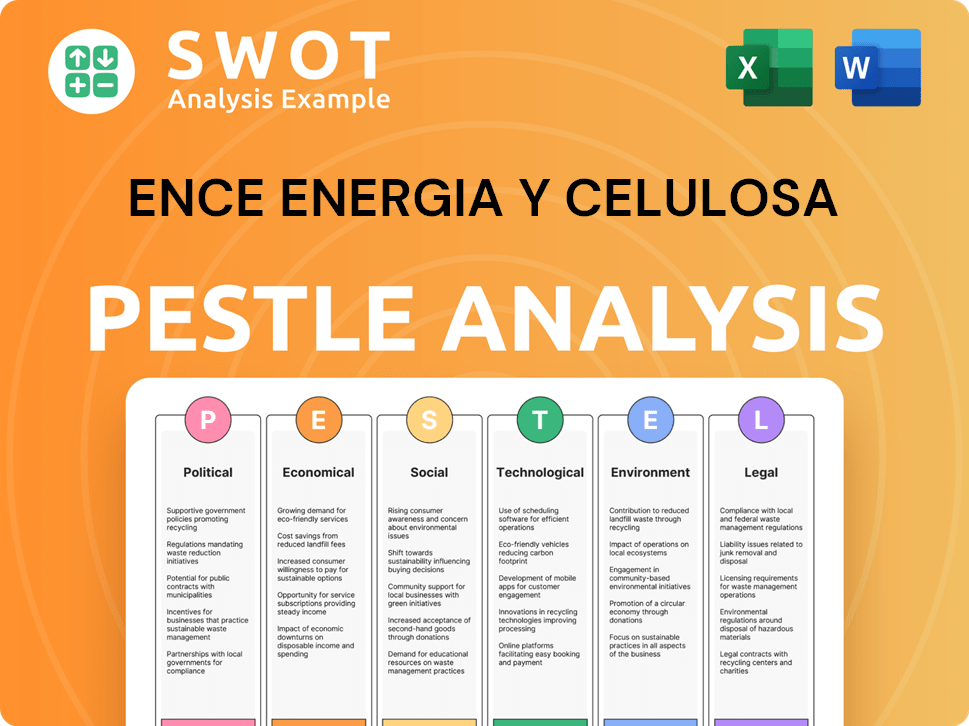
Who Sits on Ence Energia Y Celulosa’s Board?
The Board of Directors of Ence Energia Y Celulosa oversees the company's operations, aiming to create shareholder value and manage the business according to legal and regulatory requirements. The board is responsible for key strategic decisions, including the approval of the strategic plan, corporate social responsibility policies, risk management strategies, and dividend policies. They also determine the company's corporate governance framework. The responsibilities of the board are crucial for the overall success and direction of the Ence company.
While a comprehensive list of the current board members and their specific representation is not readily available in public summaries for the 2024-2025 period, Ignacio de Colmenares y Brunet serves as the Executive Chairman and CEO. The re-election of directors, including Gorka Arregui Abendivar, Javier Arregui Abendivar, and Oscar Arregui Abendivar, was proposed at the Annual General Meeting on April 3, 2024. This suggests that the Arregui family likely holds significant shareholding interests. José María Bergareche Busquet is also noted as a member of the Board of Directors. For more insights into the company's strategic direction, you can review the Growth Strategy of Ence Energia Y Celulosa.
| Board Member | Position | Notes |
|---|---|---|
| Ignacio de Colmenares y Brunet | Executive Chairman and CEO | Oversees company operations and strategy. |
| Gorka Arregui Abendivar | Director | Proprietary Director, representing shareholder interests. |
| Javier Arregui Abendivar | Director | Proprietary Director, representing shareholder interests. |
| Oscar Arregui Abendivar | Director | Proprietary Director, representing shareholder interests. |
| José María Bergareche Busquet | Director | Member of the Board of Directors. |
The voting structure at Ence Energia Y Celulosa operates on a one-share-one-vote basis. Shareholders can attend and vote at the Annual General Meeting in person or by absentee ballot. As of May 11, 2017, the total voting rights attached to shares were 246,272,500. There are no known special voting rights or founder shares that would grant outsized control to specific individuals beyond their proportional shareholding. The CEO's compensation for the year ending December 2024 was reported as €135,000. This aligns with the median for the forestry industry for companies of similar market capitalization. This information helps in understanding the Ence ownership structure and the rights of Ence shareholders.
The Board of Directors manages Ence Energia Y Celulosa, with Ignacio de Colmenares y Brunet as CEO.
- The Arregui family and other board members represent significant shareholder interests.
- Voting is based on one-share-one-vote, with no special voting rights.
- The CEO's compensation for 2024 was €135,000.
- Understanding the board and voting structure is key to analyzing Ence stock.
Ence Energia Y Celulosa Business Model Canvas
- Complete 9-Block Business Model Canvas
- Effortlessly Communicate Your Business Strategy
- Investor-Ready BMC Format
- 100% Editable and Customizable
- Clear and Structured Layout
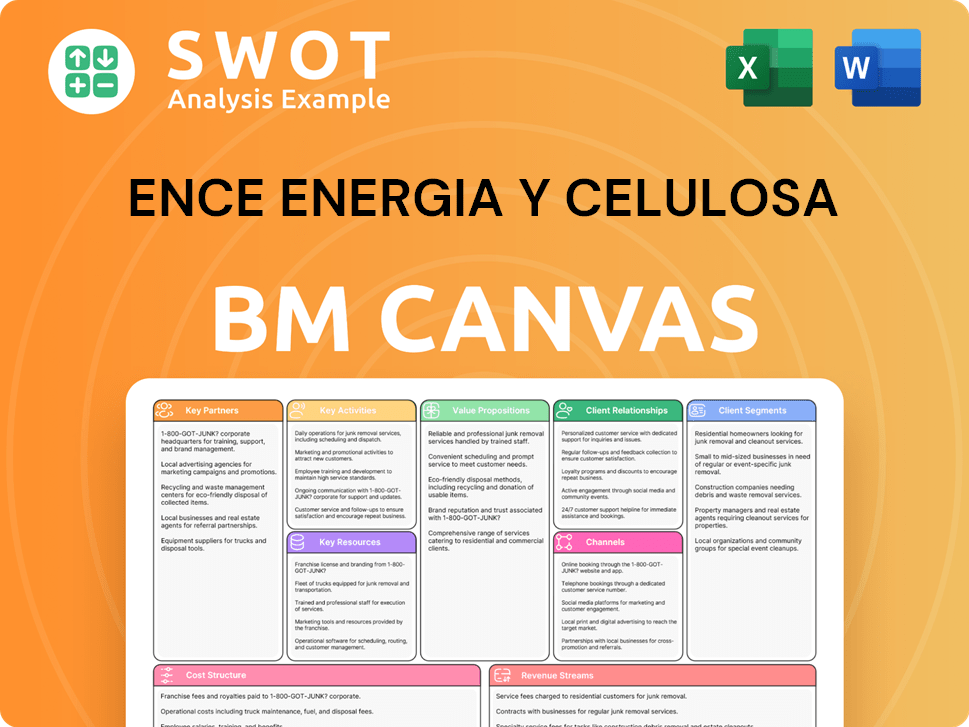
What Recent Changes Have Shaped Ence Energia Y Celulosa’s Ownership Landscape?
Over the last few years, Ence Energia Y Celulosa has focused on strengthening its core operations in pulp production and renewable energy. Recent developments highlight a strategic emphasis on sustainability and cost reduction. For the fiscal year 2024, Ence reported a net profit of €31.6 million, a significant improvement from a loss of €24.7 million in 2023. This recovery was largely driven by improved pulp prices and cost efficiencies. The company's EBITDA for 2024 nearly doubled to €164.5 million from €88.8 million in 2023.
Key ownership trends and corporate actions include continued investments in its facilities. For example, Ence plans to invest €14 million in a technical shutdown at its Navia plant and €15 million in improvements and efficiency at its Pontevedra biofactory in 2025. In December 2024, Ence completed the acquisition of a biomethane plant in Tarragona, signaling further diversification in its renewables segment. The company's strategic plan also includes creating a platform to supply over 1 TWh of biomethane annually within the next five years, with 13 projects already in the engineering and permitting phase as of June 30, 2024. The company also remunerated shareholders with €34 million in dividends in 2024, representing a 5% yield.
| Metric | 2023 | 2024 |
|---|---|---|
| Net Profit (€ million) | -24.7 | 31.6 |
| EBITDA (€ million) | 88.8 | 164.5 |
| Dividends (€ million) | N/A | 34 |
Ence's business model is increasingly focused on the circular economy, using renewable and local natural resources to produce pulp and bioproducts, and generating green energy. This aligns with broader industry trends towards decarbonization and sustainable practices. The company's dividend policy, in effect since 2022, aims to provide shareholder remuneration based on available cash while maintaining appropriate leverage levels. There is no public information indicating planned founder departures, major new strategic investors, or potential privatization/public listing changes beyond its current status as a publicly traded company.
In 2024, Ence Energia Y Celulosa saw a significant turnaround, reporting a net profit of €31.6 million, a marked improvement from the loss of €24.7 million in 2023. This positive shift was primarily due to enhanced pulp prices and improved cost management.
The company is investing heavily in its facilities. Plans include a €14 million investment in Navia and €15 million in Pontevedra in 2025. Ence also acquired a biomethane plant in Tarragona, expanding its renewable energy portfolio.
Ence is increasingly focused on the circular economy. They are using renewable resources to produce pulp and generate green energy. This aligns with the industry's move towards decarbonization and sustainable practices.
In 2024, Ence distributed €34 million in dividends. The dividend policy, in place since 2022, is designed to provide Ence shareholders with returns while maintaining appropriate financial leverage, reflecting the company's commitment to its investors.
Ence Energia Y Celulosa Porter's Five Forces Analysis
- Covers All 5 Competitive Forces in Detail
- Structured for Consultants, Students, and Founders
- 100% Editable in Microsoft Word & Excel
- Instant Digital Download – Use Immediately
- Compatible with Mac & PC – Fully Unlocked
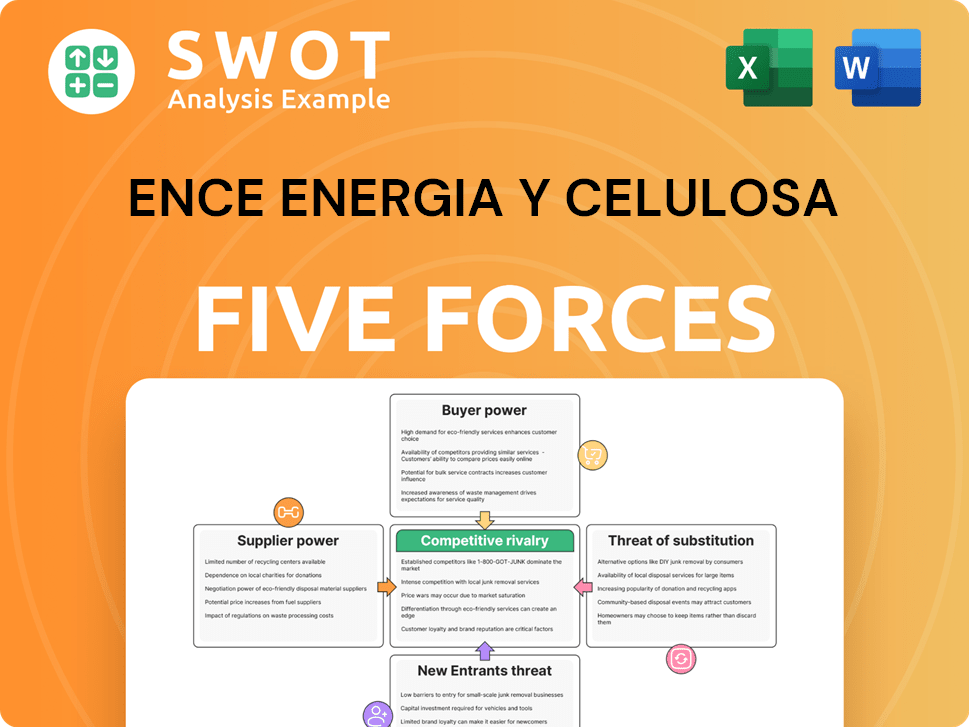
Related Blogs
- What are Mission Vision & Core Values of Ence Energia Y Celulosa Company?
- What is Competitive Landscape of Ence Energia Y Celulosa Company?
- What is Growth Strategy and Future Prospects of Ence Energia Y Celulosa Company?
- How Does Ence Energia Y Celulosa Company Work?
- What is Sales and Marketing Strategy of Ence Energia Y Celulosa Company?
- What is Brief History of Ence Energia Y Celulosa Company?
- What is Customer Demographics and Target Market of Ence Energia Y Celulosa Company?
Disclaimer
All information, articles, and product details provided on this website are for general informational and educational purposes only. We do not claim any ownership over, nor do we intend to infringe upon, any trademarks, copyrights, logos, brand names, or other intellectual property mentioned or depicted on this site. Such intellectual property remains the property of its respective owners, and any references here are made solely for identification or informational purposes, without implying any affiliation, endorsement, or partnership.
We make no representations or warranties, express or implied, regarding the accuracy, completeness, or suitability of any content or products presented. Nothing on this website should be construed as legal, tax, investment, financial, medical, or other professional advice. In addition, no part of this site—including articles or product references—constitutes a solicitation, recommendation, endorsement, advertisement, or offer to buy or sell any securities, franchises, or other financial instruments, particularly in jurisdictions where such activity would be unlawful.
All content is of a general nature and may not address the specific circumstances of any individual or entity. It is not a substitute for professional advice or services. Any actions you take based on the information provided here are strictly at your own risk. You accept full responsibility for any decisions or outcomes arising from your use of this website and agree to release us from any liability in connection with your use of, or reliance upon, the content or products found herein.